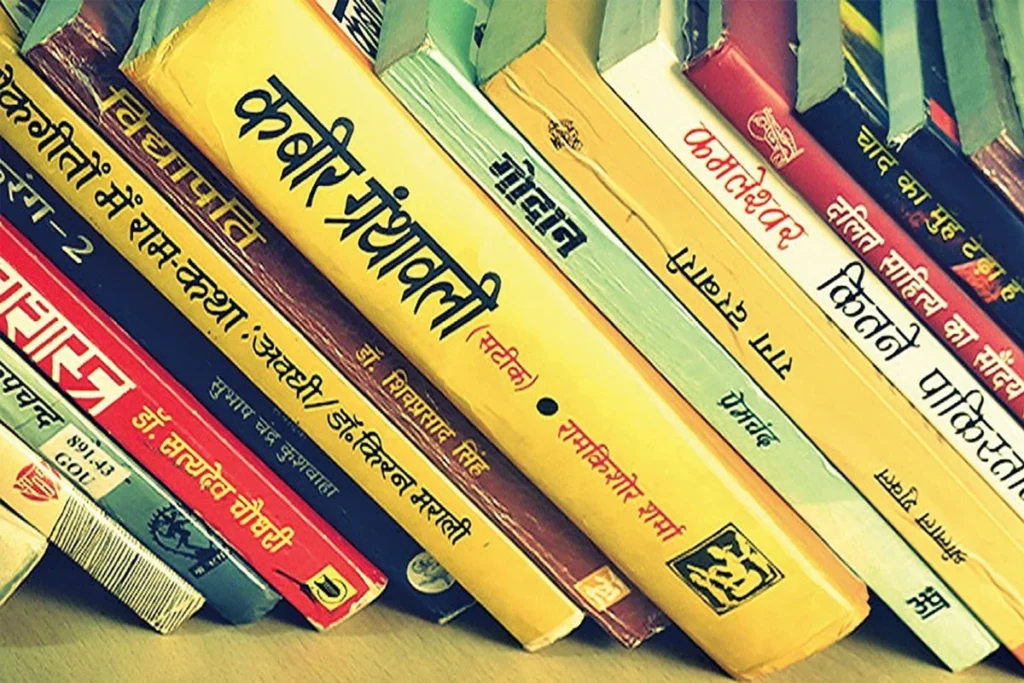Hindi literature; a garden of delight was often a tacit revolt against the literary exclusiveness of the Sanskrit scholars. Let Gaurav Goswami guide you through the different stages of Hindi literature….
A Name
The word, Hindi, is applied in a loose sense to the vernacular speech of the whole of North India between Punjab and Sindh in the west and Bengal in the east.
There are chiefly four languages in this area, namely, Rajasthani, Western Hindi, Eastern Hindi, and Bihari. Hindi has inbuilt patterns of stress and intonation.
This is because it is derived ultimately from the principles which govern Sanskrit poetry. The intellect of a skilful poet can produce pieces of wonderful charm!
Hindi Literature’s Division
At King Harsha’s death in 646 A.D, his large Empire in North India fell which led to a period of confusion and disorder, which was only resolved under the Muhammadan conquest of Delhi in 1340 A.D.
Under Muhammad Bin Tughlak. In the intermediate, various Rajput clans came into prominence which filled the vacuum of power.
This was the time when Hindi literature took its baby steps, which is generally classified into-Aadi Kaal (VeergathaKaal) 1050-1375 A.D, Early Medieval Period (Bhakti Kaal) 1375-1700 A.D, Later Medieval Period (Reeti Kaal) 1700-1900 A.D and finally Adhunik Kaal 1900- present.
Aadi Kaal, 1050-1378
It was the region of Kannauj, Delhi, Ajmer stretching up to central India where the literature of AadiKaal; war and heroism theme, developed. The earliest vernacular literature of this period appeared in the form of the Bardic chronicles of Rajput’s.
The most famous bard was Chand Bardai, whose, Prithviraj Raso, although full of eulogy and inflated with legends, and not to be taken as sober history. Nevertheless, the poem narrates the actual struggle between the Hindu King and his Muhammadan adversary.
Aadi Kaal’s division
Aadi Kaal is divided into following; Siddha literature which was propagated by Vajrayan sect of Bhuddism. The famous poets wereSarhapa, Shabrapa, and Kanhapa. Jain literature was spread by Jain monks.
In this monks propagated their religion through the medium of Hindi poetry by the use of Raasstyle. The famous among them were Ruprass, Devsen’s Shravakachan and Suri’s Revantagiri. Nath literature, Gorakhnath considered as the chief writer of this literature.
This literature came into being with the aim of improving the Siddha literature. His major works focused on detachment, praise of the guru, Kundalini awakening and samadhi. Raso literature wasbased on the heroic episodes.
The famous works include Dalpatvijaya’s Khum Raso, Sharangdhan’s Hammir Raso and Chand Bardai’s Prithviraj Raso. Apbhrash and Prakrit words were used. And, Laukik literature was written in the language of the state, Dingal.The major works were Khusro’s Paheliyan and Kushalraivachak’s Dhola Maru Ka Duha.
Bhakti kall,1375-1700
During this period communalism and superstition gained strong foothold because of the influx of Muslim religion which led to the shaking up of Hindu’s faith. Out of this turmoil, two form of worship formed, Nirgun School; believers of a formless God and Sagun School; believers of a God with attributes and worshipers of Vishnu incarnations.
Nirgun and Sagun Schools
The Nirgun form of worship divided into, Gyanashrayishaka; Kabir, Dadu Dayal and Nanak were considered notable poets who focused on divine communion and intense love and devotion towards God. And, Premashrayishaka; these poets emphasized the spiritualism inherent in earthly love and its attainment through the medium of yoga philosophy.
The Sagun School was represented mainly by Vaishnava poets who have further subdivided into Krishna margi bhakti dhara; portrayal of various activities related to Krishna.Vallabh and Nimbark were the famous exponents. And, Ram margi bhakti dhara who related to Ram. The most famous is Tuslidas’s devotional Shri Ramcharitmanas.
Reeti kaal,1700-1900
This era is called Reeti (procedure) Kaal because it was the age when poetic figure and theory were developed to the fullest. Erotic element became predominant, and stylist aspects were given more significance than the thematic aspects. Doha and Savaiyya was more popular meter.
Bihari’s Bihari Satsai a collection of Dohas dealing with Bhakti, Neeti and Shringar was the most famous book. There were poets who formed the Reetimukta poetry, they neither accepted the patronage of the Kings nor followed the set literary principles. Ghananand, Alam and Bodha Thakur were the important poets.
Adhunik kaal, 1900-present
Adhunik Kaal began after the fall of Mughal Empire and with the establishment of British rule. Scientific spirit developed and the age was marked by the spirit of realism, and the person who brought realism in Hindi prose literature was Munshi Premchand.
At the beginning of the period Lallu Ji Lal laid the foundation on modern Hindi prose and also created the literary dialect which was to be the principal medium.
Phanishwar Nath ‘Renu’ in the post Premchand period through his novel, Maila Anchal’ promoted the voice of contemporary rural India through the genre of Aanchalik Upanyas, i.e. Regional story.
Bharatendu Harishchandar is known as to have brought in a modern outlook in Hindi literature. A new trend in poetry began with the publication of the poetic collection, NaviKavita, edited by Dr.Jagdish Gupta and Dr.Ramswaroop Chaturvedi. Sumitranandan Pant’s Kala Aur Boora chand, and Dinkar’s Chakravaal were written in the trend of the new poetry.
The Final Words
Literature never dies, merely the medium changes, and it is cyber culture presently.

